The weight problems became more and more of an issue in developed countries and they affect a larger number of people each year. The same problem has hit the pets in those regions as well and it is estimated that over 50 million cats are clinically obese in the US alone along with over 30 million dogs. This can lead to serious health problems, so here’s what you should know about pet obesity.
We all want out pets to be happy and since they are always eating what we give them we think that more food will only make them happier. And then there are the treats which they get for being so good and lovable but a pet is happiest when he’s healthy, not just well fed.
The problem is that diseases like arthritis, diabetes or cardiac and respiratory diseases are what will happen when they gain weight as well as a diminished immune system that will leave them vulnerable. Even if you have an obese pet and make him/her lose weight it might be too late.
Pets don’t think about their diet or the way they look and if you give them a lot of snacks you will start feeling the fat growing on their ribs. If you can still feel the individual rib bones with ease then your pet isn’t overweight, but otherwise you have an obese companion at your side.
The diet they have should be set on a number of calories, depending on their breed, and you can determine this from the food labels (include the treats too, because they are usually the most dangerous).
Consulting your veterinarian is really important before putting the pet on a diet and exercise program since each pet is different and you might not know all the details. A sedentary lifestyle is probably what got them in that condition, but making them run all day for a week won’t solve the problem. The best approach is to start with a slow but steady exercise routine and expand it gradually.
Some breeds are predisposed to obesity and if the pet was neutered or spayed then this will also make them more likely to become overweight and this is due to the changing metabolism. The rate of loss weight should be at a maximum of 1 or 2 %, don’t force it beyond that and always remember that the purpose is to make the pet healthier, not only thinner.








Leave a Comment